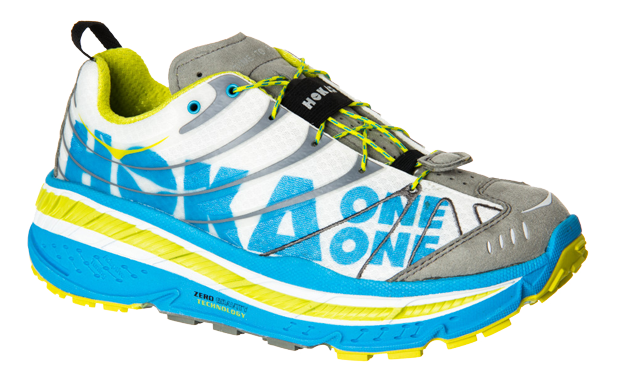
Guest Review
A relatively new entrant to the running scene, Hoka One One was founded in 2010 as a response to the minimalist trend. The models combine maximalist cushioning with minimal/mid-foot strike (i.e., ~4 mm drop) design. Since their inception, the shoes have made a splash for their oversized aesthetics and their surprising-at-least-to-me emergence as a shoe of choice for a lot of ultra runners.
The most notable feature is the massive midsole, which despite its enormous volume, brings the weight in at ~10.4 oz – certainly not the lightest shoe out there, but the weight: cushioning ratio is fantastic.
I bought the Evo Stinson Trail model primarily out of curiosity: how could a shoe so big and so ugly get such consistently high marks? In addition to (sort of) coming around on the aesthetics, I discovered that the hype is very well-deserved. The first time I put my Hokas on, it felt like I was walking around on stilts. After a few minutes, however, the feeling dissipated and gave way to a cradled springiness that’s nothing short of smile-inducing. To be sure, it’s a specific and potentially polarizing feel, but I love it.
They really do make running more fun – and not just by making recovery runs less painful. Every trail and stretch of road feels as bouncy as a track. The single best feature of the Hokas is the ability to bomb down hills with the reckless abandon of a ten year old boy. You can hurtle down steep grades as fast as your legs can turn over, and your quads and knees won’t suffer at all.
I haven’t worn them on highly technical trails, but in general, the oversized soles are as stable as any shoe and more than compensate for their exaggerated height. As a result, you can really attack most terrain without fear. The sensation is akin riding a full-suspension mountain bike: they absorb the bumps while you just keep going.
First, there’s the price. And then there’s the price. $175 before tax is a lot of money for running shoes. With all that foam, one has to wonder how it will break down over time (nb: 100 miles in, they still feel fresh). While I found the toe box to be fine, I’ve heard from a few people who have tried them on that it could stand to be wider. Out of the box, toggled speed laces are installed. I’ve stuck with them, though they do tend to slip a little at the collar by the end of a long run. For the price, it’s frustrating that you have to cut them in order to swap them out for regular laces. If you’re wearing these, you should also steel yourself for plenty of “Are those Skechers Shape Ups?” comments. At least you’ll be standing tall while you endure the mockery.
While it will never be my go-to for a flat road race, the impact forces while running are mitigated to such a strong degree that it has become my shoe of choice for both recovery runs and big hill days. For the first time in all my years of running, I actually look forward to hills. It’s such a markedly easier and less painful experience that wearing them almost feels like cheating.
Daniel is a triathlete and marathon runner (though he prefers half marathons) who splits his time between Los Angeles, CA and Durham, NC. A bit of a gear head, he logs most of his miles in low-drop, light-weight trainers but is open to anything that will help him get from to the middle of the pack to the front of the middle of the pack.
Have something to say? Leave a Comment